Investigating the Effect of Climate Change on Drought Propagation in the Tarim River Basin Using Multi-Model Ensemble Projections
Abstract
:1. Introduction
2. Study Area and Data
2.1. Study Area
2.2. Data
3. Methodology
3.1. Estimation of Drought Indices and Their Characteristics
3.1.1. Standardized Precipitation Evapotranspiration Index
3.1.2. Standardized Runoff Index
3.1.3. Standardized Terrestrial Water Storage Index
3.2. Bias Correction
3.3. Conditional Probability
4. Results and Discussion
4.1. Spatiotemporal Patterns of Drought Changes under Climate Change
4.2. Propagation Time from Meteorological to Hydrological Drought
4.3. Drought Propagation Probability
5. Conclusions
Author Contributions
Funding
Institutional Review Board Statement
Informed Consent Statement
Data Availability Statement
Conflicts of Interest
References
- Cook, B.I.; Mankin, J.S.; Marvel, K.; Williams, A.P.; Smerdon, J.E.; Anchukaitis, K.J. Twenty-First Century Drought Projections in the CMIP6 Forcing Scenarios. Earth’s Future 2020, 8, e2019EF001461. [Google Scholar] [CrossRef]
- Mishra, A.K.; Singh, V.P. A review of drought concepts. J. Hydrol. 2010, 391, 202–216. [Google Scholar] [CrossRef]
- Wilhite, D.A.; Glantz, M.H. Understanding: The Drought Phenomenon: The Role of Definitions. Water Int. 1985, 10, 111–120. [Google Scholar] [CrossRef]
- Huang, J.; Yu, H.; Dai, A.; Wei, Y.; Kang, L. Drylands Face Potential Threat under 2 °C Global Warming Target. Nat. Clim. Chang. 2017, 7, 417–422. [Google Scholar] [CrossRef]
- Ma, Z.; Fu, C.; Yang, Q.; Zheng, Z.; Lü, M.; Li, M.; Duan, Y.; Chen, L. Drying Trend in Northern China and Its Shift during 1951–2016. Chin. J. Atmos. Sci. 2018, 42, 951–961. [Google Scholar] [CrossRef]
- Miao, L.; Ye, P.; He, B.; Chen, L.; Cui, X. Future Climate Impact on the Desertification in Dry Land Asia Using AVHRR GIMMS NDVI3g Data. Remote Sens. 2015, 7, 3863–3877. [Google Scholar] [CrossRef]
- Li, Z.; Hao, Z.; Shi, X.; Déry, S.J.; Li, J.; Chen, S.; Li, Y. An Agricultural Drought Index to Incorporate the Irrigation Process and Reservoir Operations: A Case Study in the Tarim River Basin. Glob. Planet. Chang. 2016, 143, 10–20. [Google Scholar] [CrossRef]
- Xia, J.; Yang, P.; Zhan, C.; Qiao, Y. Analysis of Changes in Drought and Terrestrial Water Storage in the Tarim River Basin Based on Principal Component Analysis. Hydrol. Res. 2019, 50, 761–777. [Google Scholar] [CrossRef]
- Chen, Y.-N.; Li, W.-H.; Xu, C.-C.; Hao, X.-M. Effects of Climate Change on Water Resources in Tarim River Basin, Northwest China. J. Environ. Sci. 2007, 19, 488–493. [Google Scholar] [CrossRef]
- Zhao, L.; Lyu, A.; Wu, J.; Hayes, M.; Tang, Z.; He, B.; Liu, J.; Liu, M. Impact of Meteorological Drought on Streamflow Drought in Jinghe River Basin of China. Chin. Geogr. Sci. 2014, 24, 694–705. [Google Scholar] [CrossRef]
- Yang, P.; Xia, J.; Zhang, Y.; Zhan, C.; Sun, S. How is the Risk of Hydrological Drought in the Tarim River Basin, Northwest China? Sci. Total Environ. 2019, 693, 133555. [Google Scholar] [CrossRef] [PubMed]
- Zhang, X.; Hao, Z.; Singh, V.P.; Zhang, Y.; Feng, S.; Xu, Y.; Hao, F. Drought Propagation under Global Warming: Characteristics, Approaches, Processes, and Controlling Factors. Sci. Total Environ. 2022, 838 Pt 2, 156021. [Google Scholar] [CrossRef] [PubMed]
- Zeng, J.; Li, J.; Lu, X.; Wei, Z.; Shangguan, W.; Zhang, S.; Dai, Y.; Zhang, S. Assessment of Global Meteorological, Hydrological and Agricultural Drought under Future Warming Based on CMIP6. Atmos. Ocean. Sci. Lett. 2022, 15, 100143. [Google Scholar] [CrossRef]
- Eyring, V.; Bony, S.; Meehl, G.A.; Senior, C.A.; Stevens, B.; Stouffer, R.J.; Taylor, K.E. Overview of the Coupled Model Intercomparison Project Phase 6 (CMIP6) Experimental Design and Organization. Geosci. Model Dev. 2016, 9, 1937–1958. [Google Scholar] [CrossRef]
- The CMIP6 landscape. Nat. Clim. Chang. 2019, 9, 727. [CrossRef]
- O’Neill, B.C.; Kriegler, E.; Riahi, K.; Ebi, K.L.; Hallegatte, S.; Carter, T.R.; Mathur, R.; van Vuuren, D.P. A New Scenario Framework for Climate Change Research: The Concept of Shared Socioeconomic Pathways. Clim. Chang. 2014, 122, 387–400. [Google Scholar] [CrossRef]
- Wu, L. Tarim River Basin Boundary; National Cryosphere Desert Data Center: Lanzhou, China, 2023. [Google Scholar] [CrossRef]
- Yang, J.; Huang, X. The 30 m annual land cover datasets and its dynamics in China from 1985 to 2022. Datasets 2023, 1, 8176941. [Google Scholar] [CrossRef]
- Yu, Y.; Yu, R.; Chen, X.; Yu, G.; Gan, M.; Disse, M. Agricultural Water Allocation Strategies along the Oasis of Tarim River in Northwest China. Agric. Water Manag. 2017, 187, 24–36. [Google Scholar] [CrossRef]
- Muñoz Sabater, J. ERA5-Land Hourly Data from 1950 to Present; Copernicus Climate Change Service (C3S) Climate Data Store (CDS): Reading, UK, 2019. [Google Scholar] [CrossRef]
- Beaudoing, H.; Rodell, M.; NASA/GSFC/HSL. GLDAS Noah Land Surface Model L4 Monthly 0.25 × 0.25 Degree V2.0; Goddard Earth Sciences Data and Information Services Center (GES DISC): Greenbelt, MD, USA, 2019. [Google Scholar] [CrossRef]
- Rodell, M.; Houser, P.R.; Jambor, U.; Gottschalck, J.; Mitchell, K.; Meng, C.; Arsenault, K.; Cosgrove, B.; Radakovich, J.; Bosilovich, M.; et al. The Global Land Data Assimilation System. Bull. Am. Meteor. Soc. 2004, 85, 381–394. [Google Scholar] [CrossRef]
- Guo, H.; Bao, A.; Chen, T.; Zheng, G.; Wang, Y.; Jiang, L.; De Maeyer, P. Assessment of CMIP6 in Simulating Precipitation Over Arid Central Asia. Atmos. Res. 2021, 252, 105451. [Google Scholar] [CrossRef]
- Zhang, X.; Hua, L.; Jiang, D. Assessment of CMIP6 model performance for temperature and precipitation in Xinjiang, China. Atmos. Ocean. Sci. Lett. 2022, 15, 100128. [Google Scholar] [CrossRef]
- Vicente-Serrano, S.M.; Beguería, S.; López-Moreno, J.I. A Multiscalar Drought Index Sensitive to Global Warming: The Standardized Precipitation Evapotranspiration Index. J. Clim. 2010, 23, 1696–1718. [Google Scholar] [CrossRef]
- Allen, R.G.; Pereira, L.S.; Raes, D.; Smith, M. Crop Evapotranspiration-Guidelines for Computing Crop Water Requirements-FAO Irrigation and Drainage Paper 56; FAO: Rome, Italy, 1998; Volume 300, p. D05109. Available online: https://www.fao.org/3/X0490E/x0490e00.htm (accessed on 15 January 2023).
- Li, H.; Li, Z.; Chen, Y.; Xiang, Y.; Liu, Y.; Kayumba, P.M.; Li, X. Drylands Face Potential Threat of Robust Drought in the CMIP6 SSPs Scenarios. Environ. Res. Lett. 2021, 16, 114004. Available online: https://iopscience.iop.org/article/10.1088/1748-9326/ac2bce (accessed on 24 May 2023). [CrossRef]
- Shukla, S.; Wood, A.W. Use of a Standardized Runoff Index for Characterizing Hydrologic Drought. Geophys. Res. Lett. 2008, 35, L02405. [Google Scholar] [CrossRef]
- McKee, T.B.; Doesken, N.J.; Kleist, J. The Relationship of Drought Frequency and Duration to Time Scales. In Proceedings of the 8th Conference on Applied Climatology, Anaheim, CA, USA, 17–22 January 1993; Volume 17, pp. 179–183. Available online: https://climate.colostate.edu/pdfs/relationshipofdroughtfrequency.pdf (accessed on 20 May 2023).
- Li, L.; Zhao, L.; Ge, J.; Yang, P.; Wu, F. Investigating Drought Propagation Time, Relationship, and Drivers in Perennial River Basins of China. Water 2022, 14, 2812. [Google Scholar] [CrossRef]
- Cui, A.; Li, J.; Zhou, Q.; Zhu, R.; Liu, H.; Wu, G.; Li, Q. Use of a Multiscalar GRACE-Based Standardized Terrestrial Water Storage Index for Assessing Global Hydrological Droughts. J. Hydrol. 2021, 603, 126871. [Google Scholar] [CrossRef]
- Lian, H.; Han, X.; Liu, Y.; Han, Y.; Yang, W.; Xiong, W. Study on Spatiotemporal Characteristics of Atmospheric Drought from 1981 to 2020 in the Mu Us Sandy Land of China Based on SPEI Index. J. Desert Res. 2022, 42, 71–80. [Google Scholar]
- Li, S.; Zeng, L.; Zhang, C.-J.; Xiao, C.; Zhang, Q.; Gong, W.-T. Spatio-temporal Variations and Propagation from Meteorological to Hydrological Drought in the Upper Yangtze River Basin Over the Last 120 Years. Adv. Clim. Chang. Res. 2023, 19, 263–277. [Google Scholar]
- Tong, Y.; Gao, X.; Han, Z.; Xu, Y.; Xu, Y.; Giorgi, F. Bias Correction of Temperature and Precipitation Over China for RCM Simulations Using the QM and QDM Methods. Clim. Dyn. 2021, 57, 1425–1443. [Google Scholar] [CrossRef]
- Shin, Y.; Lee, Y.; Choi, J.T.; Park, J.-S. Integration of Max-Stable Processes and Bayesian Model Averaging to Predict Extreme Climatic Events in Multi-Model Ensembles. Stoch. Environ. Res. Risk Assess. 2018, 33, 47–57. Available online: https://api.semanticscholar.org/CorpusID:125289406 (accessed on 3 January 2023). [CrossRef]
- Jehanzaib, M.; Sattar, M.N.; Lee, J.-H.; Kim, T.-W. Investigating Effect of Climate Change on Drought Propagation from Meteorological to Hydrological Drought Using Multi-Model Ensemble Projections. Stoch. Environ. Res. Risk Assess. 2020, 34, 7–21. [Google Scholar] [CrossRef]
- Tan, Y.X.; Ng, J.L.; Huang, Y.F. Spatiotemporal Variability Assessment and Accuracy Evaluation of Standardized Precipitation Index and Standardized Precipitation Evapotranspiration Index in Malaysia. Earth Sci. Inform. 2023, 16, 67–89. [Google Scholar] [CrossRef]
- Guo, H.; Bao, A.; Liu, T.; Jiapaer, G.; Ndayisaba, F.; Jiang, L.; Kurban, A.; De Maeyer, P. Spatial and Temporal Characteristics of Droughts in Central Asia During 1966–2015. Sci. Total Environ. 2018, 624, 1523–1538. [Google Scholar] [CrossRef] [PubMed]
- Ding, Y.; Xu, J.; Wang, X.; Cai, H.; Zhou, Z.; Sun, Y.; Shi, H. Propagation of meteorological to hydrological drought for different climate regions in China. J. Environ. Manag. 2021, 283, 111980. [Google Scholar] [CrossRef] [PubMed]
- Huang, S.; Huang, Q.; Chang, J.; Leng, G.; Xie, Y. The propagation from meteorological to hydrological drought and its potential influence factors. J. Hydrol. 2017, 547, 184–195. [Google Scholar] [CrossRef]
- Shi, P.; Tang, H.; Qu, S.; Wen, T.; Zhao, L.; Li, Q. Characteristics of Propagation from Meteorological Drought to Hydrological Drought in Southwest China. Water Resour. Prot. 2023, 39, 49–56. [Google Scholar] [CrossRef]
- Barker, L.J.; Hannaford, J.; Chiverton, A.; Svensson, C. From meteorological to hydrological drought using standardised indicators. Hydrol. Earth Syst. Sci. 2016, 20, 2483–2505. [Google Scholar] [CrossRef]
- Kumar, R.; Musuuza, J.L.; Van Loon, A.F.; Teuling, A.J.; Barthel, R.; Ten Broek, J.; Mai, J.; Samaniego, L.; Attinger, S. Multiscale Evaluation of the Standardized Precipitation Index as a Groundwater Drought Indicator. Hydrol. Earth Syst. Sci. 2016, 20, 1117–1131. [Google Scholar] [CrossRef]
- Intergovernmental Panel on Climate Change. Climate Change 2007: Impacts, Adaptation and Vulnerability; Intergovernmental Panel on Climate Change: Geneva, Switzerland, 2001; Available online: https://www.ipcc.ch/report/ar4/wg2/ (accessed on 15 December 2023).
- Li, R.; Wang, C.; Wu, D. Changes in Precipitation Recycling over Arid Regions in the Northern Hemisphere. Theor. Appl. Climatol. 2018, 131, 489–502. [Google Scholar] [CrossRef]
- Li, R.; Wang, C. Precipitation Recycling Using a New Evapotranspiration Estimator for Asian-African Arid Regions. Theor. Appl. Climatol. 2020, 140, 1–13. [Google Scholar] [CrossRef]
- Zhan, Y.J.; Zhang, W.; Yan, Y.; Wang, C.X.; Rong, Y.J.; Zhu, J.Y.; Lu, H.T.; Zheng, T.C. Analysis of actual evapotranspiration evolution and influencing factors in the Yangtze River Basin. Acta Ecol. Sin. 2021, 41, 6924–6935. [Google Scholar]
- Wang, C.; Zhang, S.; Zhang, F.; Li, K.; Yang, K. On the Increase of Precipitation in Northwestern China Under Global Warming. Adv. Earth Sci. 2021, 36, 980–989. [Google Scholar] [CrossRef]
- Zhang, L.; Yu, Y.; Malik, I.; Wistuba, M.; Sun, L.; Yang, M.; Wang, Q.; Yu, R. Water Resources Evaluation in Arid Areas Based on Agricultural Water Footprint—A Case Study on the Edge of the Taklimakan Desert. Atmosphere 2023, 14, 67. [Google Scholar] [CrossRef]
- He, J.; Li, B.; Yu, Y.; Sun, L.; Zhang, H.; Malik, I.; Wistuba, M.; Yu, R. Temporal Variability of Temperature, Precipitation and Drought Indices in Hyper-Arid Region of Northwest China for the Past 60 Years. Atmosphere 2022, 13, 1561. [Google Scholar] [CrossRef]
- Sun, Y.; Chen, X.; Yu, Y.; Qian, J.; Wang, M.; Huang, S.; Xing, X.; Song, S.; Sun, X. Spatiotemporal Characteristics of Drought in Central Asia from 1981 to 2020. Atmosphere 2022, 13, 1496. [Google Scholar] [CrossRef]
- Abu Arra, A.; Şişman, E. Characteristics of Hydrological and Meteorological Drought Based on Intensity-Duration-Frequency (IDF) Curves. Water 2023, 15, 3142. [Google Scholar] [CrossRef]
- Cheval, S. The Standardized Precipitation Index—An overview. Rom. J. Meteorol. 2015, 12, 17–64. [Google Scholar]
- Laimighofer, J.; Laaha, G. How standard are standardized drought indices? Uncertainty components for the SPI & SPEI case. J. Hydrol. 2022, 613, 128385. [Google Scholar] [CrossRef]
- Yao, N.; Zhao, H.; Li, Y.; Biswas, A.; Feng, H.; Liu, F.; Pulatov, B. National-Scale Variation and Propagation Characteristics of Meteorological, Agricultural, and Hydrological Droughts in China. Remote Sens. 2020, 12, 3407. [Google Scholar] [CrossRef]
- Wang, A.; Wang, Y.; Su, B.; Kundzewicz, Z.W.; Tao, H.; Wen, S.; Qin, J.; Gong, Y.; Jiang, T. Comparison of changing population exposure to droughts in river basins of the Tarim and the Indus. Earth’s Future 2020, 8, e2019EF001448. [Google Scholar] [CrossRef]
- Liu, Y.; Chen, Y. Impact of Population Growth and Land-Use Change on Water Resources and Ecosystems of the Tarim River Basin in Western China. Int. J. Sustain. Dev. World Ecol. 2006, 13, 295–305. [Google Scholar] [CrossRef]
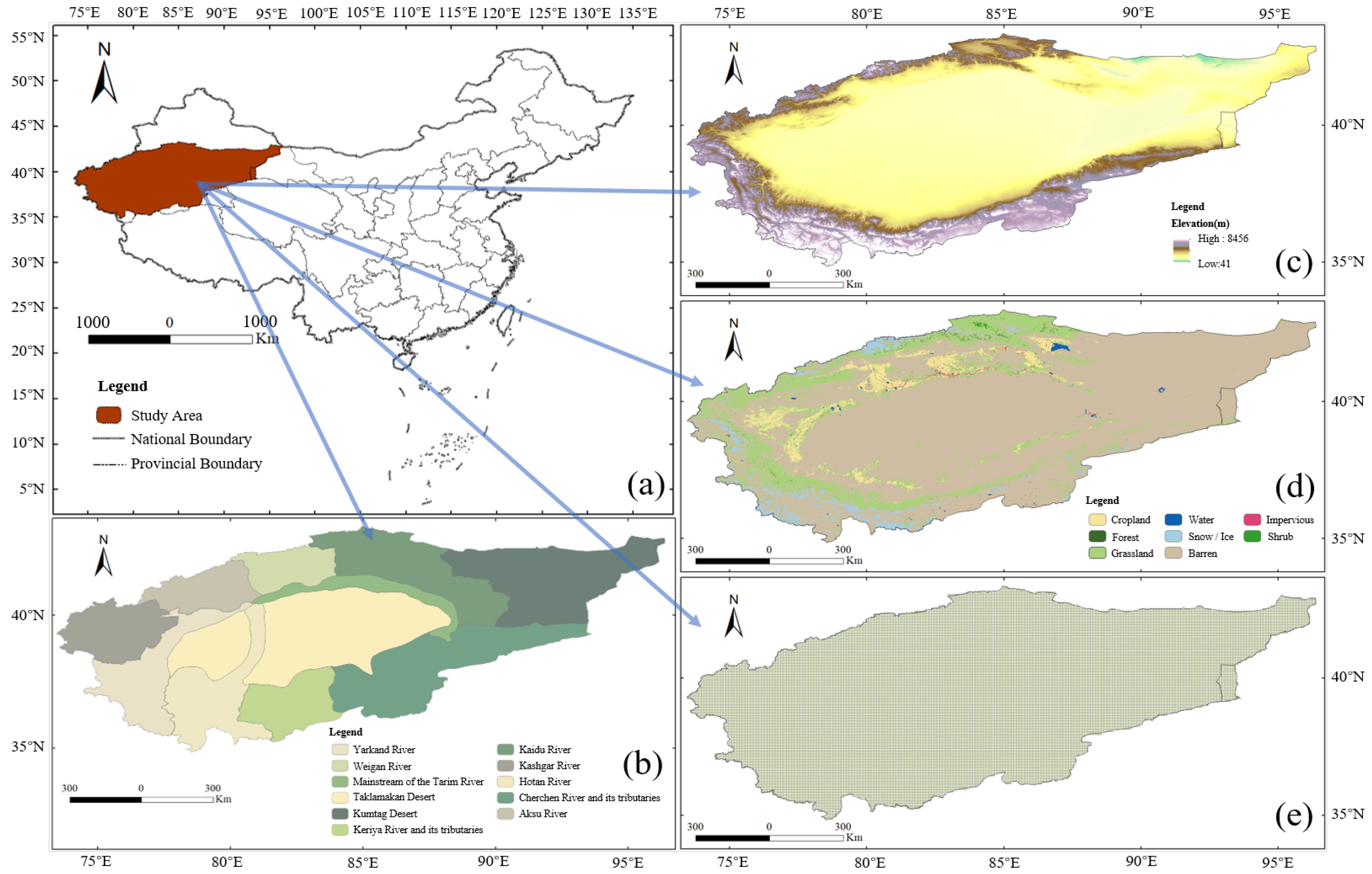
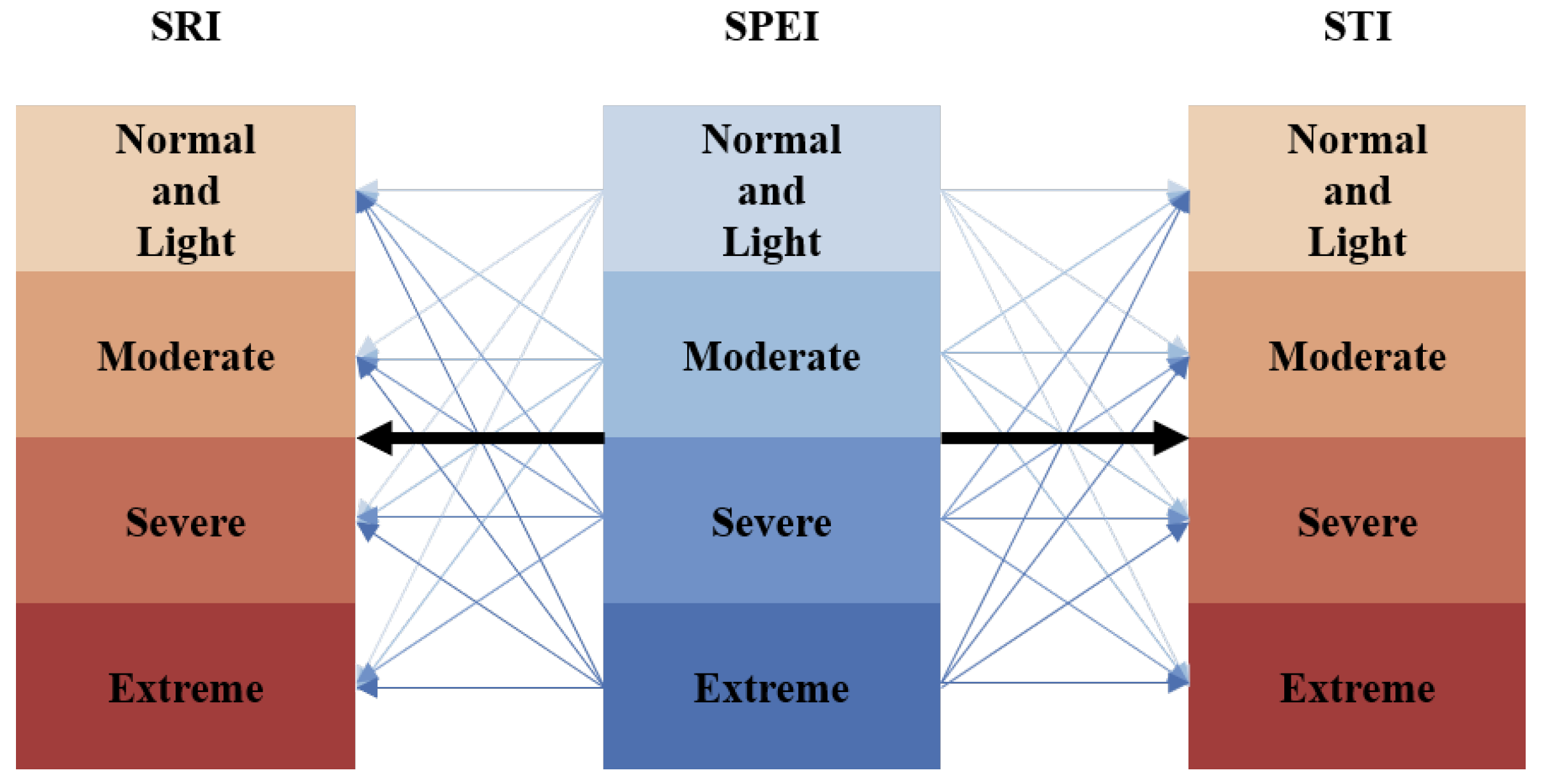
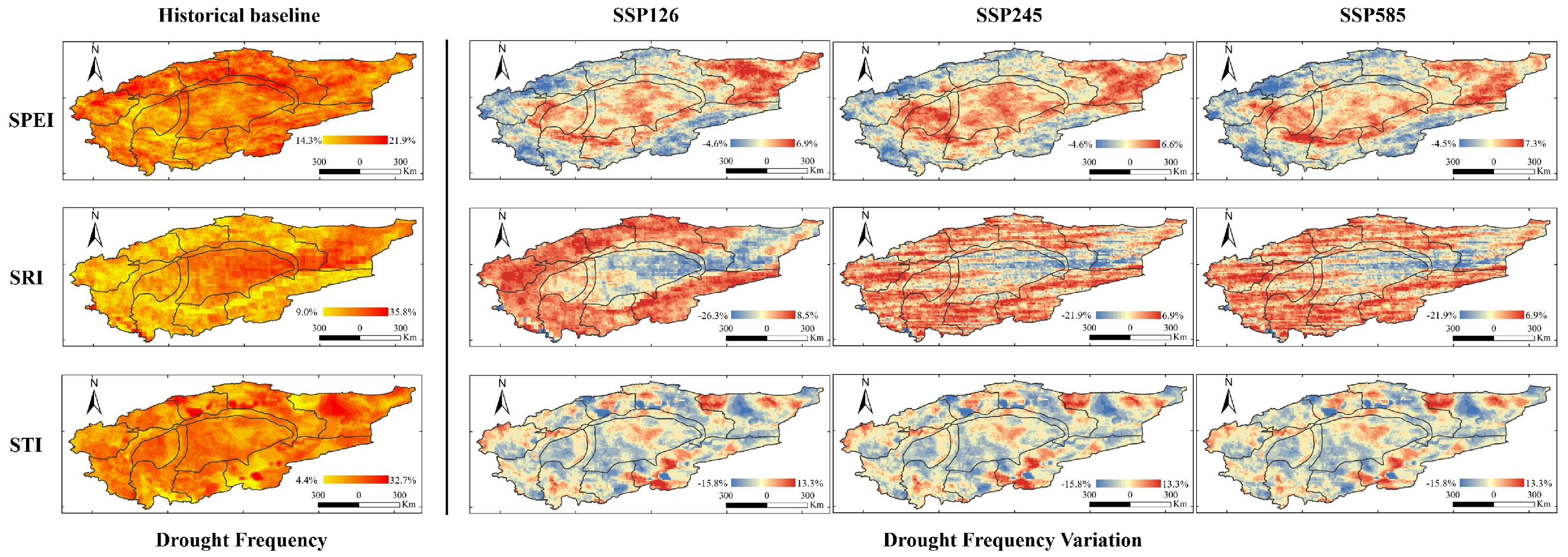
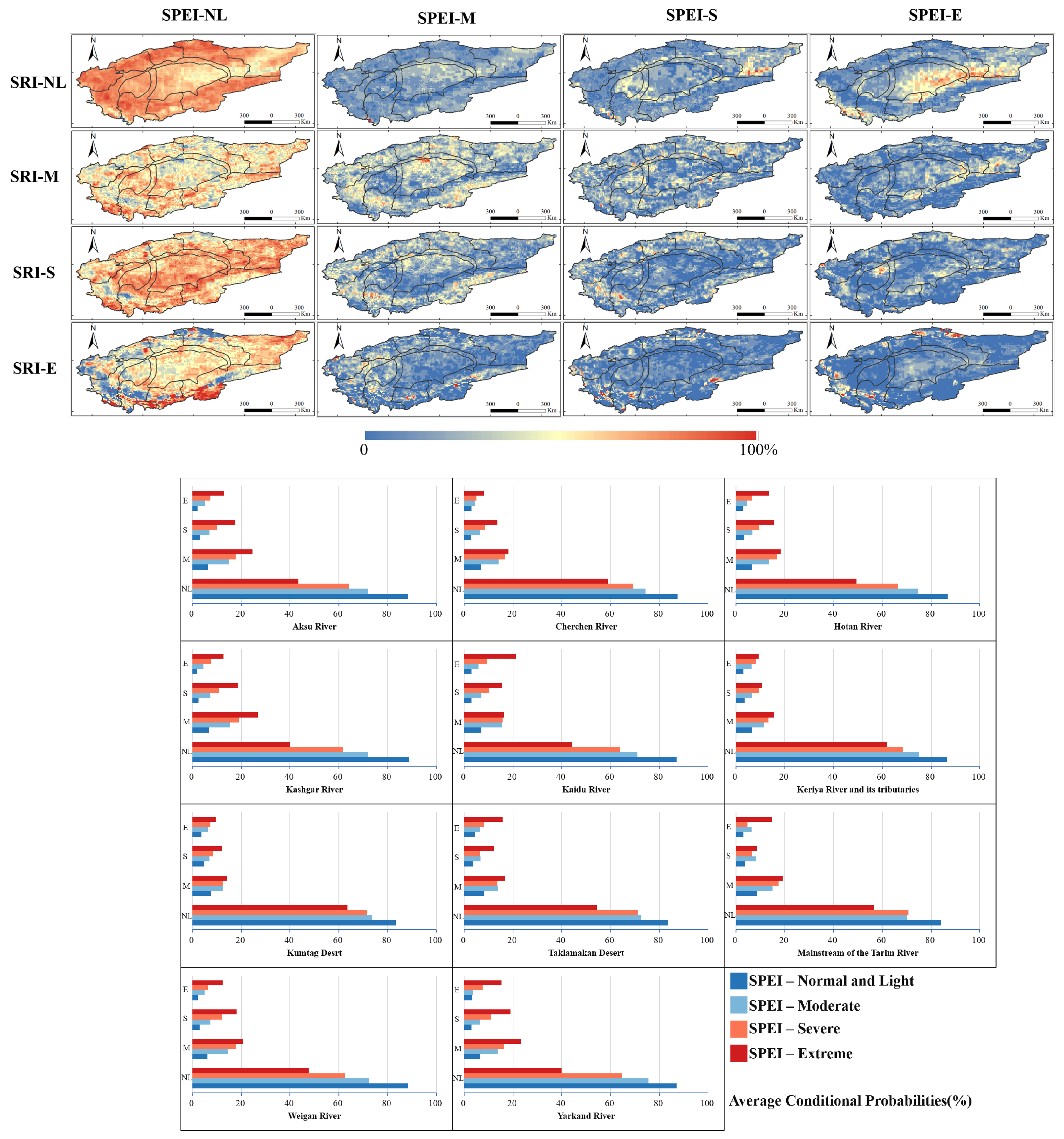

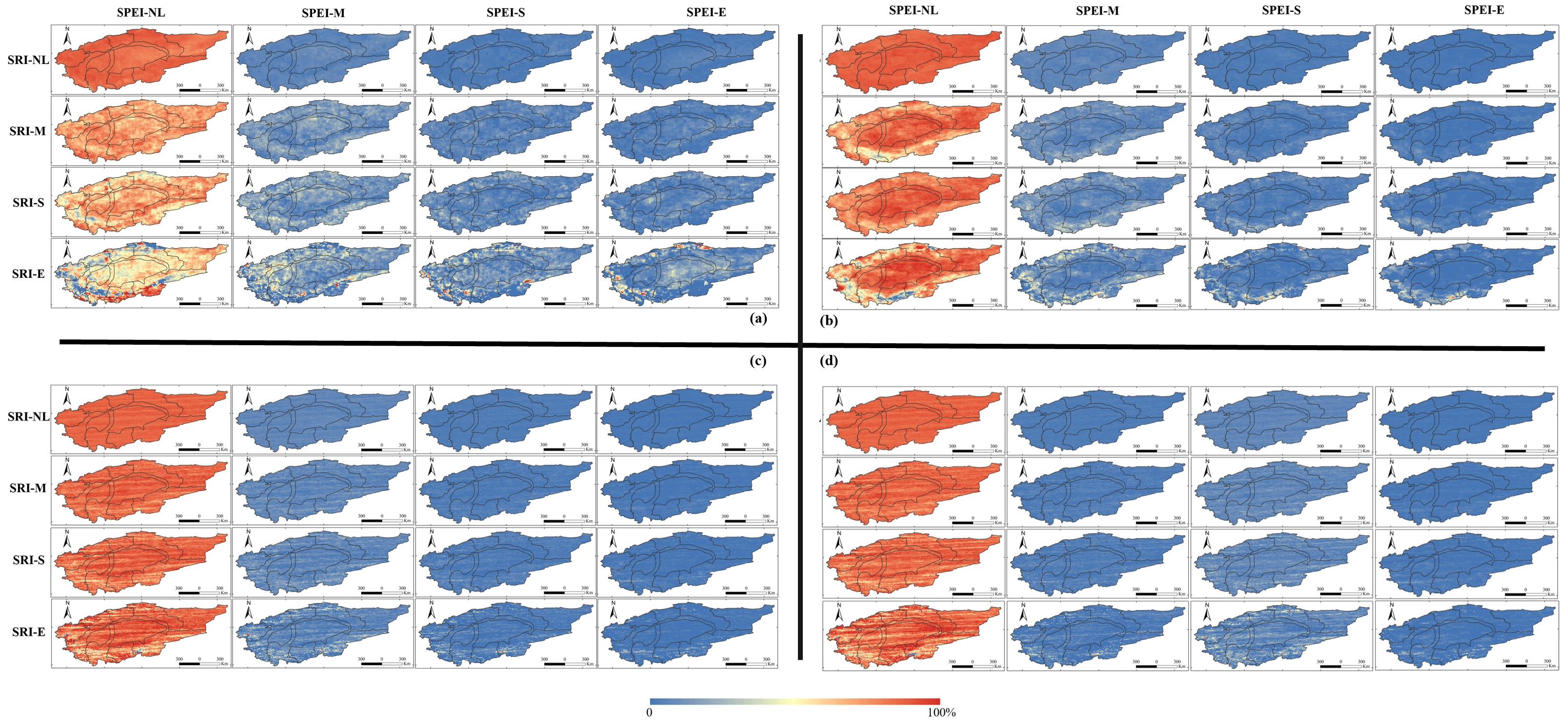
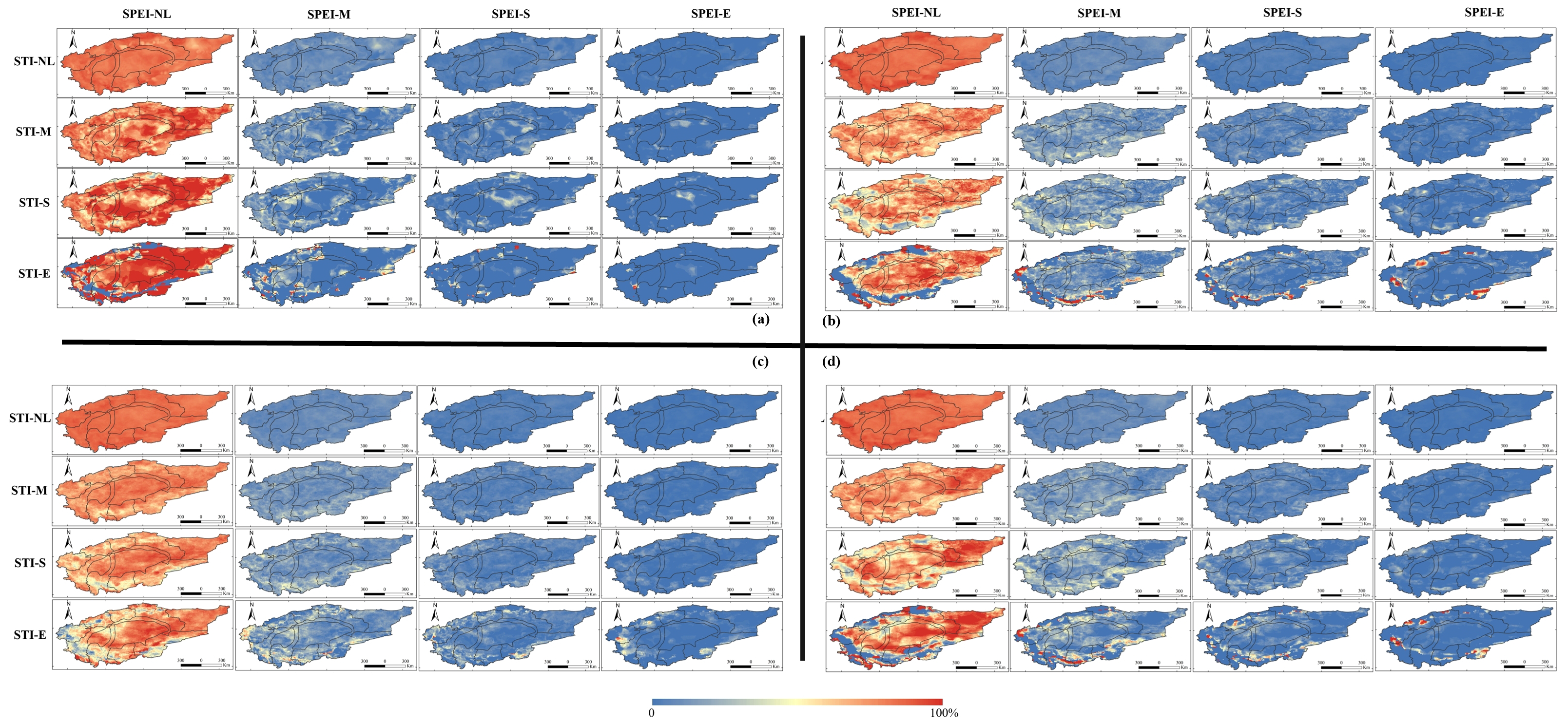
| Model | Institute | Horizontal Resolution |
|---|---|---|
| ACCESS-ESM1-5 | Commonwealth Scientific and Industrial Organization (CSIRO) | |
| EC-Earth3 | EC-Earth-Consortium | |
| EC-Earth3-Veg | EC-Earth-Consortium | |
| GFDL-ESM4 | Geophysical Fluid Dynamics Laboratory (NOAAGFDL) | |
| IPSL-CM6A-LR | Institute Pierre Simon Laplace (IPSL) |
| Categorization | SPEI/SRI/STI |
|---|---|
| Normal and Light | ≥−1.00 |
| Moderate | to |
| Severe | to |
| Extreme | ≤−2.00 |
Disclaimer/Publisher’s Note: The statements, opinions and data contained in all publications are solely those of the individual author(s) and contributor(s) and not of MDPI and/or the editor(s). MDPI and/or the editor(s) disclaim responsibility for any injury to people or property resulting from any ideas, methods, instructions or products referred to in the content. |
© 2023 by the authors. Licensee MDPI, Basel, Switzerland. This article is an open access article distributed under the terms and conditions of the Creative Commons Attribution (CC BY) license (https://creativecommons.org/licenses/by/4.0/).
Share and Cite
Ding, X.; Yu, Y.; Yang, M.; Wang, Q.; Zhang, L.; Guo, Z.; Zhang, J.; Mailik, I.; Malgorzata, W.; Yu, R. Investigating the Effect of Climate Change on Drought Propagation in the Tarim River Basin Using Multi-Model Ensemble Projections. Atmosphere 2024, 15, 50. https://doi.org/10.3390/atmos15010050
Ding X, Yu Y, Yang M, Wang Q, Zhang L, Guo Z, Zhang J, Mailik I, Malgorzata W, Yu R. Investigating the Effect of Climate Change on Drought Propagation in the Tarim River Basin Using Multi-Model Ensemble Projections. Atmosphere. 2024; 15(1):50. https://doi.org/10.3390/atmos15010050
Chicago/Turabian StyleDing, Xiaoyun, Yang Yu, Meilin Yang, Qian Wang, Lingyun Zhang, Zengkun Guo, Jing Zhang, Ireneusz Mailik, Wistuba Malgorzata, and Ruide Yu. 2024. "Investigating the Effect of Climate Change on Drought Propagation in the Tarim River Basin Using Multi-Model Ensemble Projections" Atmosphere 15, no. 1: 50. https://doi.org/10.3390/atmos15010050





